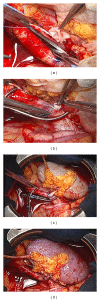Successful Kidney Transplantation for End-Stage Renal Disease in Marfan's Syndrome
- PMID: 24093072
- PMCID: PMC3777197
- DOI: 10.1155/2013/809613
Successful Kidney Transplantation for End-Stage Renal Disease in Marfan's Syndrome
Abstract
Marfan's syndrome is a systemic disorder of the connective tissue caused by mutations in the extracellular matrix protein fibrillin-1, with aortic dissection and aneurysm being its most life-threatening manifestations. Kidney transplantation for end-stage renal disease (ESRD) in patients with Marfan's syndrome has not been reported in the literature, and the rate of the incidence of dissection or aneurysm in the iliac artery is unknown. Here, we present a patient with Marfan's syndrome with ESRD due to severe renal ischemia caused by massive bleeding from thoracoabdominal aortic dissection leading to transplant surgery of a living kidney procured from the patient's mother. After kidney transplantation, the renal function normalized without vascular complications, and stable graft function along with negative results for both microhematuria and proteinuria continued for two years. Also, vascular complication such as aneurysm or dissection of the iliac artery was not observed using ultrasonography during the follow-up period. ESRD patients with Marfan's syndrome might be suitable for kidney transplantation, but long-term and careful observations are needed.
Figures


Similar articles
-
Successful kidney transplantation from donor with Marfan's syndrome.Am J Transplant. 2006 Aug;6(8):1972-4. doi: 10.1111/j.1600-6143.2006.01389.x. Am J Transplant. 2006. PMID: 16889552
-
[Influence of acute aortic dissection on long-term results of aortic root reconstruction in patients with Marfan's syndrome].Kyobu Geka. 1998 Jul;51(8 Suppl):651-5. Kyobu Geka. 1998. PMID: 9742797 Japanese.
-
The Bentall procedure in patients with Marfan's syndrome.J Card Surg. 1997 Mar-Apr;12(2 Suppl):142-6. J Card Surg. 1997. PMID: 9271738
-
Aortic root disease in athletes: aortic root dilation, anomalous coronary artery, bicuspid aortic valve, and Marfan's syndrome.Sports Med. 2013 Aug;43(8):721-32. doi: 10.1007/s40279-013-0057-6. Sports Med. 2013. PMID: 23674060 Review.
-
Marfan's syndrome and surgical repair of ascending aortic aneurysms.AORN J. 1996 Dec;64(6):895-913; quiz 916-8, 921-2. doi: 10.1016/s0001-2092(06)63601-6. AORN J. 1996. PMID: 8960679 Review.
References
-
- Januzzi JL, Marayati F, Mehta RH, et al. Comparison of aortic dissection in patients with and without Marfan’s syndrome (results from the International Registry of Aortic Dissection) American Journal of Cardiology. 2004;94(3):400–402. - PubMed
-
- Januzzi JL, Isselbacher EM, Fattori R, et al. Characterizing the young patient with aortic dissection: results from the international registry of aortic dissection (IRAD) Journal of the American College of Cardiology. 2004;43(4):665–669. - PubMed
-
- Murdoch JL, Walker BA, Halpern BL, Kuzma JW, McKusick VA. Life expectancy and causes of death in the Marfan syndrome. New England Journal of Medicine. 1972;286(15):804–808. - PubMed
-
- LeMaire SA, Jones MM, Conklin LD, et al. Randomized comparison of cold blood and cold crystalloid renal perfusion for renal protection during thoracoabdominal aortic aneurysm repair. Journal of Vascular Surgery. 2009;49(1):11–19. - PubMed
LinkOut - more resources
Full Text Sources
Other Literature Sources

